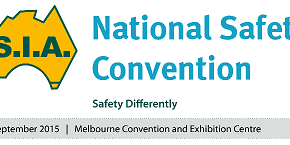The Safety Institute of Australia’s National Safety Convention 2015 is going to be held on 16-17 September 2015, at the Melbourne Convention and Exhibition Centre.
This Convention will bring together industry thought leaders and will encourage national and global involvement across the two days, outlining the need for change in systems and how looking beyond safety disciplines may be the answer.
Compliance Experts are a proud SIA Silver Corporate Sponsor and will also be sponsoring the plenary session titled “Challenging the Paradigm”
Having worked in the HSE Industry for over 25+ years, we know firsthand that doing compliance for the sake of ticking the box doesn’t add value back to business.
In this article we explain how HSE (Health, Safety and Environment) practitioners can better manage Work Health and Safety.
Workplace Safety is not only a moral obligation but also one that can carry legal ramifications should your obligations not be met. Australian law dictates strong workplace safety laws under the WHS Act. Specifically this means, persons conducting a business or undertaking are required to monitor the health of workers and the conditions at the workplace, to ensure safety is maintained within the workplace. It really can be a matter of life or death for employees.
This might sound dramatic but if you consider that already 125 workers have been killed whilst at work this year alone according to the Safe Work Australia website, then the gravity of needing to have a very clear understanding of workplace safety obligations really hits home.
WHS is broad and covers so many areas that it’s easy to get confused about what your obligations may be, leaving your company open to disaster, in some cases without even realising it.
- Are we over complicating WHS Compliance and missing the key point?
- Do we need to challenge the existing paradigm and re-think our approach to WHS Compliance and the value that it adds back to business?
- Where is the starting point to ensure safety for employees?
- What can you do to sleep soundly at night knowing you have covered all bases morally, legally and proactively?
The absolute best practice here in Australia and also now around the world, to comply with workplace safety law, is to conduct regular audits. However, the issue of what exactly you are auditing, though, can sometimes bring up more questions and confusion about what areas to focus on for your business purposes:
- Managing Safety – How strong is employee knowledge of how to report an accident? How sound is your employment training?
- Environment – Are your surroundings safe? Are you on a worksite or in an office setting?
- Equipment, Machinery & Tools – Are all of your tools at current safety standards? Are there clear instructions for all machine operators to follow?
- Job Safety – Are all aspects of your employees jobs covered in your policy and procedures?
- Hazardous Manual Handling – Are you aware of every manual handling risk within your business?
- Electricity – Do you feel confident that all electronic sources are safe within the workplace area?
- Chemicals – Do your employees handle chemicals and are they fully aware of all risks and how to avoid danger?
- Working at heights – If your employees are working from heights are there preventative policies and/or infrastructure in place for potential falls?
- Emergency Procedures and First Aid – If an accident occurs, are the staff equipped to administer first aid? Do you have an evacuation procedure in place for a fire or other emergency?
- Return to work – In the unfortunate incident of an employee who has had an accident, are you prepared for their return to work?
As we can see, the topic of WHS management is broad, and safeguarding your company against accidents, injuries and even death can be overwhelming when trying to ensure you have every base covered. Questions can lead to more questions so it’s important you are asking exactly the right ones. Not only that, but it’s the answers you provide that will keep employees covered.
Compliance Experts is committed to enhancing compliance via our state of the art compliance auditing application, Compliance Checkpoint.







